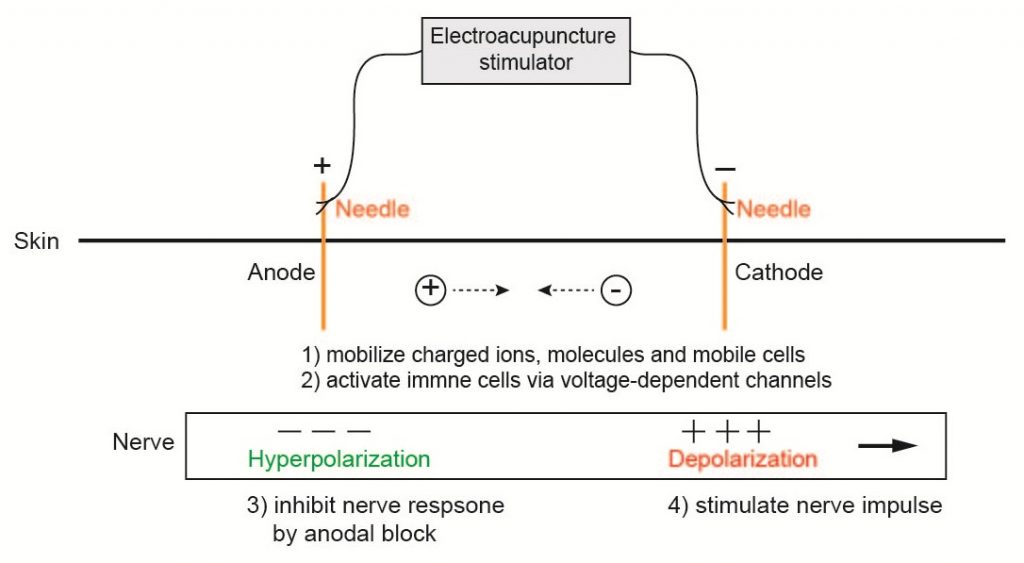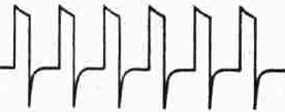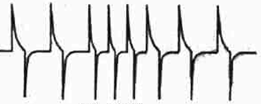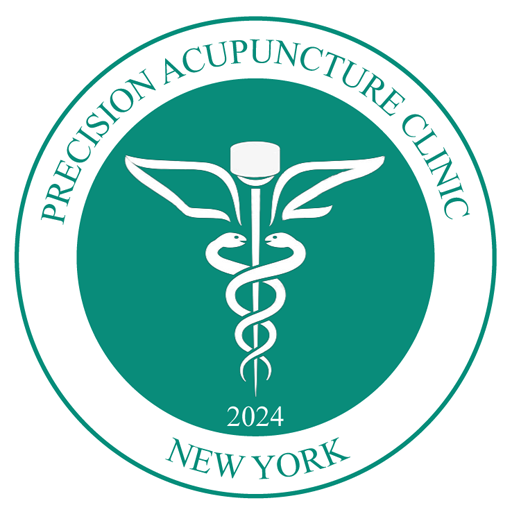Origin of electroacupuncture
Compared to the long history of (regular) acupuncture, electroacupuncture emerged as a result of the application of direct current (DC) onto human bodies. In 1816, a French physician called Louis Berlioz proposed the use of electrical shock to acupuncture needles to enhance the effects. In 1825, the first treatise on electroacupuncture, Memoires sur l’electropuncture, was published by a French physician called Jean-Baptiste Sarlandière, who reported treatment of rheumatic and neurological disorders with DC discharged from Leyden jars on thin metal needles. In 1934, a Chinese professor, Shicheng Tang, applied pulsed current in acupuncture treatment and elucidated three major effects of electroacupuncture: 1) electrical stimulation of nerves or muscles, 2) inhibition of nerve excitation at the anode, and 3) mobilize the removal of the wastes from tissue. However, the key development of modern electroacupuncture happened in 1956 when a Chinese doctor called Longyu Zhu published his research on animals and clinical acupuncture treatments in patients using electroacupuncture stimulators that generate various currents, including pulsed current. Now, as a widely used acupuncture method, electroacupuncture mainly applies biphase pulsed currents on the acupuncture needles inserted into specific acupoints to treat various diseases.
Mechanisms of electroacupuncture

Schematic to show the electric effects on the molecules, cells, and nerves under the skin in one of the two phases of a biphasic wave (Opposite current direction in the other phase)
As shown in the above figure, electroacupuncture establishes a temporary electrical field in the tissue under the skin via the anode and cathodes. This electrical field generates the following possible mechanisms that can explain the therapeutic effects of electroacupuncture:
1) promote the movement of charged ions, molecules, and cells to activate local tissue metabolism, blood and tissue fluid flow, and tissue repair;
2) activate immune cells, particularly innate immune cells, by influencing their voltage-dependent channels on their cell membrane, which in turn may regulate the function of those cells to help fight against damages and repair the local tissue;
3) inhibit neuronal response by generating hyperpolarization in their axon, dendrites, or soma;
4) stimulate neuronal signals by generating depolarization in their axon, dendrites, or soma;
5) stimulate distal effects along acupuncture meridians.
Clinical conditions treated by electroacupuncture
Based on the above analysis and clinical practice, electroacupuncture is used to treat the following clinical conditions:
1) Pain of muscles and nerves;
2) Local inflammation;
3) Reduced function of muscles such as flaccidity and paralysis;
4) Injury of muscles, tendons, joints;
5) Neurological diseases such as neurasthenia.
On the other hand, patients with the following conditions should avoid the use of electroacupuncture: common contradictions of regular acupuncture, pregnancy, using a pacemaker, history of seizures, severe heart diseases, etc.
Parameters of electroacupuncture
Clinically important parameters of the pulsed current used in electroacupuncture include frequency, waveform, intensity, duration, interval, and connection.
1) Frequency: low frequency (< 30 Hz, usually 2 ~ 5 Hz), high frequency (> 30 Hz, usually 50 ~ 100 Hz)
2) Waveform: three commonly used forms
Continuous wave

Sparse-dense wave

Intermittent wave

3) Intensity: low (no visible muscle contraction), medium (visible muscle contraction), high (apparent muscle contraction)
4) Duration: 10 ~ 20 minutes (continuous or intermittent)
Clinically important parameters of electroacupuncture include frequency, waveform, intensity, duration, interval, and connection.
5) Interval: 1/day to 1/week
Frequency: low frequency (< 30 Hz, usually 2 ~ 5 Hz), high frequency (> 30 Hz, usually 50 ~ 100 Hz)
At Precision Acupuncture Clinic, we have adopted the use of biphasic pulsed current as it is a bidirectional wave with one positive phase and one negative phase to reduce the risk of harmful tissue reactions. Further, we use the following electroacupuncture strategy in our practice:
1) Dense continuous wave (high frequency of 30 ~ 100 Hz) to inhibit sensory and then motor nerves to reduce pain, calm and relax muscles and blood vessels
2) Sparse continuous wave (low frequency of 2-5 Hz) to excite muscle contraction to stimulate muscles with reduced function (note: prolonged duration can inhibit sensory and motor nerves)
3) Intermittent wave (regularly paused wave) to excite muscle contraction
4) Sparse-dense wave (alternate sparse wave and dense wave) to increase local tissue metabolism and fluid (blood and tissue fluid) mobility to reduce inflammation
In addition, we implement precision electroacupuncture that uses customized, precise parameters of electro-stimulation for each patient to reach effective therapeutic outcomes.
Schedule Appointments
Only one patient can be scheduled for one treatment hour, which ensures that each patient receives full attention during the clinic visit. However, a patient can come early to wait in the waiting area.
Please book an appointment online by clicking the Book an Appointment icon. The direction to our clinic can be found by clicking the Google Maps icon. Please feel free to contact us by email or phone.
Dr. Zhou’s availability:
If you have any issues with booking an appointment at your convenient time, please do not hesitate to contact us at (929)688-2567 or info@precisionacupunctureclinic.com. We will do our best to accommodate you.
We are located at
90 North Broadway
Suite 211
Irvington, NY 10533
